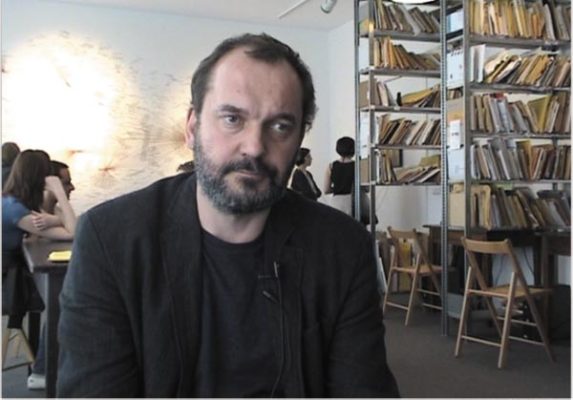Search
To search for an exact match, type the word or phrase you want in quotation marks.
A*DESK has been offering since 2002 contents about criticism and contemporary art. A*DESK has become consolidated thanks to all those who have believed in the project, all those who have followed us, debating, participating and collaborating. Many people have collaborated with A*DESK, and continue to do so. Their efforts, knowledge and belief in the project are what make it grow internationally. At A*DESK we have also generated work for over one hundred professionals in culture, from small collaborations with reviews and classes, to more prolonged and intense collaborations.
At A*DESK we believe in the need for free and universal access to culture and knowledge. We want to carry on being independent, remaining open to more ideas and opinions. If you believe in A*DESK, we need your backing to be able to continue. You can now participate in the project by supporting it. You can choose how much you want to contribute to the project.
You can decide how much you want to bring to the project.

The Berlin Biennale presents an edition charged with political content. The global context directs how one understands what to do through art, with its limitations and institutions. Artur Żmijewski positions himself at the delicate crossroads between publics, art, institutions, representation and political action.
SAIOA OLMO: Paying attention to the selected artworks at Berlin Biennale, most of them are related to conflicts among countries, religions and policies. What about micropolitics? Do they have also their place in the biennial?
ARTUR ŻMIJEWSKI: Micropolitics?… Micropolitics or macropolitics. I didn’t think about it. It is not part of the concept, micro or macro.
SO: Should we value socially engaged art in terms of its artisticity and in terms of its social efficiency at the same level? How is it possible proposing an experimental process and assuring social efficiency at the same time?
AŻ: I think these artworks are not experimental and this is not an experimental exhibition. This people use quiet traditional technics, performances, they develop photographs, they make movies, videos. The visual approach is quite traditional. There is not too much experiment in it. But hopefully there is some political approach in it.
SO: Which people will this biennial actually reach to? Art lovers, social activists, children, unemployed people, politicians…? Which role will they play? Spectator, co-creators, collaborators?
AŻ: Art lovers for sure will come, kids also, because there will be special events for kids, there will be also, on Sunday, a Battle of Berlin 1945, a kind of family event, in the park, in Spreepark, so it is just a mass event in fact. So who will come, whether politicians, mothers or kids, I would expect all of them, somehow because it is very open. It really has this open character, open atmosphere.
SO: You have made several strategies of recontextualizating an artwork or something in another place. In relation with authorship, what happens there? When you take for instance the key of this refugee camp in Palestine and you put it here, or the billboard of the Egyptian telephonic company, who is the author?
AŻ: In case of the key there is a collective author, a group of people from Aida Refugee Camp form Palestine so they made it collectively, they cut metal and constructed this object. In this case we don’t want to forget about context. It is not decontextualization or recontextualization of it. The context of the key is the Palestinian struggle. In case of Mobinil, the advertising company is the author of it, of this banner. And we don’t want to forget about the context of this banner. This banner represents a certain ideological approach. The company Mobinil is using the image of the people on the Tahrir Square in Egypt, in Cairo for the advertising campaign and at the same time this company cut connections when the revolution started, when these riots started, when the people started to demand changing the country. So we don’t want to decontextualize it. We want to show not really a banner, an object, a key itself or a banner itself but the whole history which is behind it, which makes it important for us, for other people.
SO: In relation with “Occupy the Biennial”, is it not a bit strange, to invite a movement to occupy an institution? Occupation is not supposed to be by invitation.
AŻ: They were not invited to occupy the institution, we wanted to cooperate with them and we just wanted them to be here, to continue their work. The name “Occupy Biennale” came from them.
SO: About the Artwiki project, there has been an open call, 5.000 portfolios, 2 portfolios has been selected. Have you reinforced with this open call a division between first class artists, the ones in the exhibition, and second class artists, the ones in the artwiki? Was it a realistic promise the chance of taking part in the biennial?
AŻ: It was a little different, because we sent an open call to the artists and the answer really shifted my aim. We started to think what to do with this because you can try to go through it and then select a really small number of artists and then present them, but then it is really art competition. So finally the idea of Artwiki appeared, the idea conducted by, developed by Pit Schultz to transform all these portfolios into a digital archive called artwiki, in which artists are allowed to edit their profiles, upload images, movies whatever they want, and transform all of this to a kind of open public archive free source of information about the artists and artistic activities. So that was the idea.
SO: For the Artwiki archive, you have asked people about their ideological inclination. May I ask you for your political and religious inclinations to be able to situate the knowledge that I can take from the biennial?
AŻ: I think it doesn’t matter what is my political stand because if I would say “I am leftist” it doesn’t mean that it is a leftist biennial. It is just not the situation in which you have a certain position of the curator and the same meaning of the exhibition. In the open call I asked the artist about their political inclination because in my opinion it is important to have opinion. And within the art world it is somehow forbidden to be politically defined. And also I wanted to know what are the political stands of the artists.
SO: The artist Martin Zet has launched the campaign “Germany gets rid of it” asking people to donate and collect copies of Thilo Sarrazin’s book “Germany Does Away with Itself” (which has controversial approaches to immigration policies) to make an art installation and after the biennial collectively decide what to do with them. It has provoked multiple interpretations of the artist’s intentions with this action, associating it with the burning of books. Does the wide range of interpretations that receptors can make of an artwork, becomes problematic when art is dealing with political issues that usually are presented in terms of “pro” and “against”? Art can have a lot of interpretations but when you come to a political point you are usually driven to be “against” or “pro”.
AŻ: In general I think that such limits of art and politics is unusual. Politics is very complicated and I think that it is more complicated than art, in fact more difficult and I don’t think there are so black and white positions. There is a spectrum of positions, choices, strategies, understandings of it.
SO: Referring to “Christ the King”, when you invited Miroslaw Patecki to make the Jesuschrist’s head inside the biennial context, were you talking about the ideological political, religious meanings that his piece would take inside the biennial? He is a sculptor but that he is also catholic. How was the work of Miroslaw Patecki commissioned?
AŻ: It started from the figure of Jesus, Christ the King, which is located in the in the city of Świebodzin, and the figure is very famous because it is very big, it’s also in the middle of nowhere, just in the field, next to a small city. It is 33 m high and quite impressive, so we found out who is the author of it. There was a meeting with Miroslaw Patecki and we tried to convince him to take part in the Berlin Biennial and to show a small part of it in the original size. So we were thinking about either both hands or about head and finally we had head of Jesus, of “Christ the King” production in KunstWerke.
SO: Participation and “open artworks”, how important is for you the idea of openness? I mean, there are artworks in which a situation is displayed and what will happen is open to the participants. Artworks in which everything is not closed by the artist at the beginning but depends on the people that take part in that artwork.
AŻ: Yes, the idea of openness is important, for example there is a second exhibition venue in St. Elisabeth Church. There is a Draftsmen’s Congress initiated by Pawel Althamer. The people can participate, can go there, change everything if something is painted by you and I don’t like it I can demolish it. There is freedom to express your opinions.
SO: About this idea of transformation, will you do some kind of meeting with the communities or the people involved in the biennial to assess the biennials effects? I don’t mean in a statistical or a quantitative way but something like sharing what has happened.
AŻ: Yes, there is a plan to have a big meeting in six weeks with participants in the biennial and the people who are interested in it and to ask questions, again, where we are and which way we expect to go. So there will be like an evaluation of the exhibition. I like to know what it is done or what will be done, what we are doing, how people react on it. It’s on.

Saioa Olmo is interested in the mysterious beings that people are: with their manias, passions, patterns of behaviour and unpredictability…and above all the way they relate to each other and the context within which they move. Her artistic practice revolves around group behaviour and through her texts she tries to establish connections between the knowledge and experiences she gains while sniffing around in this area.
"A desk is a dangerous place from which to watch the world" (John Le Carré)